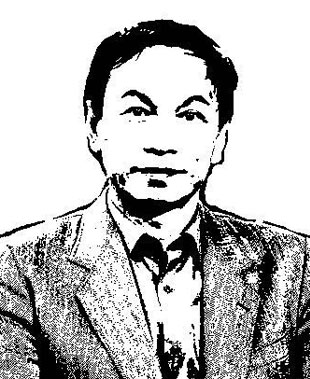张岱何许人也?如果不是读了四川文艺出版社1996年出版的张岱的《夜航船》附《陶庵梦忆》《西湖梦寻》,我对他也比较陌生。读了这本书这后,不仅对这位伟大的爱国作家有了深刻了解,而且还像着迷似地喜欢上他的小品散文。其特点概括说来,以文报国,隽永清新。
张岱(1597—1679),字宗子,一字石公,别号陶庵,又号蝶庵居士,山阴(今浙江绍兴)人。是明代末期杰出的小品散文家。而学者黄裳称张岱为“是一位历史学家,市井诗人,又是一位绝代散文家。”我同意黄裳的前两个评价。张岱一生著作甚丰,据他的《自为墓志铭》所述,他“有《石匮书》、《张氏家谱》、《义烈传》、《琅huan文集》(注:那个字打不出来,是个女字旁+擐字的右半边:意思是皇帝藏书的地方)、《明易》、《大易用》、《史阙》、《四书遇》、《梦忆》、《说铃》、《昌谷解》、《快园道古》、《傒囊十集》、《西湖梦寻》、《一卷冰雪文》行世。 ”此外,还有《有明越三不朽名贤图赞》、《琯朗乞巧录》数种,以及《夜航船》。我认为他的书大部分是在研究历史,而诗作精品不多。他的散文称不上“绝代”,但是他的小品散文非常杰出,成为明清小品散文的佼佼者。最著名的传世作品当属《陶庵梦忆》。
什么是小品?据学者冉云飞的研究,小品的概念最初来源于佛经的略本,它起始于晋代,《释氏辩空》中说:“详者为大品,略者为小品。”明晚期出现了一批以写抒情为主的小品散文作家,张岱就是其中“领袖群伦的一位。”(引子冉云飞《挽救江湖·代序言》)
为什么张岱的小品散文集《陶庵梦忆》最有影响?这不仅由于此书收集了他许多小品名篇,还由于他写这部书的背景十分令人叹息。张岱在序言中说:“年至五十,国破家亡”,他便“披发入山”成为一个野人。避迹山居后,“所存者破床碎几,折鼎病琴,与残书数帙,缺砚一方而已,布衣蔬食,常至断炊。”而朋友探望他见他如此境遇惊愕得已经认不出他了,“如毒药猛兽,愕室不敢与接”。张岱因生活困顿,前途无望,“作诗自挽,每欲自决”。但是,因《石匮书》一书未成,不得不苟延残喘。(可惜的是他的那本《石匮书》写成后,几经散失,没能流传于世。)他坚持写作,“鸡鸣枕上,夜气方回,因想余生平,繁华靡丽,过眼皆空,五十年来,总成一梦。”“遥思往事,忆记书之”,“偶拈一则,如游旧径,如见故人” 为的是能让世人记住明朝的往事,因此他像着了魔一样,乐此不疲,“坚固如佛家舍利,劫火猛烈,犹烧之不失也。”(见四川文艺出版社1996年版《夜航船》第423页)张岱这种拳拳的爱国之情,深深打动每一位读者的心。
《陶庵梦忆》一共八卷,卷一收录了《钟山》、《报恩塔》等15篇小品散文。卷二收录了《孔庙桧》、《孔林》、《燕子矶》等15篇小品散文。卷三收录了《湖心亭看雪》、《白洋湖》等16篇小品散文。卷四收录了《秦淮河房》、《兖州阅武》等15篇小品散文。卷五收录了《于园》、《虎丘中秋夜》、《扬州瘦马》等16篇小品散文。卷六收录了《绍兴灯景》、《烟雨楼》等16篇小品散文。卷七收录了《西湖七月半》、《闺中秋》、《过剑门》等17篇小品散文。卷八收录了《龙山放灯》、《楼船》等13篇小品散文。可以这本书说集中了张岱小品散文的精华。
首先,给我的感受是张岱的所有小品散文作品充满着爱国主义的情怀,他不仅个人不食“清”粟,而且在极端困顿、饥饿颓唐的情况下写了大量的怀念明朝的一草一木的作品,以文报国。如写《钟山》,除了写钟山的巍峨苍郁,王气、龙锐藏焉,更主要写它是高皇帝等历代君王的陵寝,如今被伤气脉。因此,“孝陵玉石二百八十二年,今岁清明,乃遂不得一盂麦饭,思之猿咽。(同上书第426页)他写《报恩塔》“中国之大古董,永乐之大窑器、则报恩塔是也,报恩塔成于永乐初年,非成祖开国之精神、开国之物力、开国之功令、其胆智才略足以吞吐此塔者,不能成焉。”他记叙道:“永乐时,海外夷蛮重译者百有余国,见报恩塔必须顶礼赞叹而去,谓四大部洲所无也。”忆物思故国,拳拳报国情,通过对过去繁华生活的片断记录,反映了他对国破家亡的感慨,流露着追怀故国、热爱乡土的爱国思想,这些是洋溢在他小品散文中的最主要思想特色。
其次,我认为隽永清新、短小精悍是张岱小品散文的又一大艺术特色。如《湖心亭看雪》“崇祯五年十二月,余住西湖。大雪三日,湖中人鸟声俱绝。是日更定矣,余拿一小舟,拥毳衣炉火,独往湖心亭。看雪雾凇沅砀,天与云与山与水上下一白。湖上影子惟长堤一痕,湖心亭一点,与余舟一芥,园中人两三粒而已。到亭上,有两人铺毡对坐,一童子烧酒,炉正沸。见余大惊喜,曰:‘湖中焉得更有此人’!拉余同饮。余强饮三大白而别。问其姓氏,是金陵人,客此。及下船,舟子喃喃曰:‘莫说相公痴,更有痴似相公者’。”(见同上书第445页)文章寥寥百余字,却别具一格地描绘出大雪无痕,天水一色,亭、堤、人、舟渺小如粒的俯瞰景致,而舟子评论痴情恋雪景的人竟然还有同类,更是点睛之笔。文章隽永清新,读之如品甘茗。
再其次,观察细腻,描写自然,记叙人事,情态可掬,描摹尽致。如他的名篇《西湖七月半》“西湖七月半,一无可看,止可看看七月半之人。看七月半之人,以五类看之:其一楼船箫鼓,峨冠盛宴,灯火优傒,声光相乱,名为看月而不看月者,看之;其一亦船亦楼,名姓闺秀,携及童娈,笑啼杂之,张坐露台,左右盼望,身在月下而实不看月者,看之;其一亦船亦声歌,名妓闲僧,浅斟低唱,弱管轻丝,竹肉相发,亦在月下,亦看月而欲看人看其看月者,看之。其一不舟不车,衣衫不帻,酒醉饭饱,呼群三五,跻入人丛,昭庆断桥,鴞呼嘈杂,装假醉,唱无腔曲,月亦看,看月者亦看,不看月者亦看,而实无一看者,看之;其一小船轻幌,净几暖炉,茶铛旋煮,萦瓷静递,好友佳人,邀月同坐,或匿影树下,或逃嚣里湖,看月而不见月之态,亦不作意看月者,看之。杭人游湖,巳出酉归,避月如仇。是夕好名,逐队争出,多犒门军酒钱,轿夫擎燎,列俟岸上。一入舟,速舟子急放断桥,赶入胜会。以故二鼓以前,人声鼓吹,如沸如撼,如魇如呓,如聋如哑,大船小船一齐凑岸,一无所见,止见篙击篙,舟击舟,面看面而已。。。。。。。”(见同上书第470页)在张岱的描写下,西湖赏月的人群,各类各色,跃然纸上,自然而生动。
再再其次,题材广泛,凡名胜风景,世俗风情,戏曲技艺,古董玩具等等,无所不记,而且语言清新活泼,体裁如散文诗,让人读了难以忘怀,并击节称快!如《白洋湖》写他观钱塘海潮:“立塘上,见潮头一线,从海宁而来,直奔塘上。稍近,则隐隐露白,如驱千百群小鹅,擘翼惊飞。渐近喷沫,冰花蹴起,如百万雪狮蔽江而下,怒雷鞭之,万首镞镞,无敢后先。再近,则飓风逼之,势欲拍岸而上。看者辟易,走避塘下。潮到塘,尽力一礴,水击射,溅起数丈,著面皆湿。旋卷而右,龟山一挡,轰怒非常,炮碎龙湫,半空雪舞。看之惊眩,坐半日,颜始定。”(见同上书第441页)那形象的比喻“千百群小鹅”、“百万雪狮”被怒雷鞭赶,咆哮争先的潮头场面,让人如临其境,感受到震撼,读之怎能忘怀?读之怎能不击节叫好?!
总之,这是一本值得一读的好书,几乎篇篇珠玑,让人陶醉。朋友,如果你有兴趣,一定要买上一本,静静细读,肯定受益匪浅。
Severing the Nation with Meaningful and Fresh Words—Appreciation of Zhang Dai’s Essay
By Wang Yongli
Zhang Dai: who is he? If I had not read Shipping in the Night, The Memory in Tao Cottage and Dreaming In the West Lake published by Sichuan Literature Press, 1996 edition, I would have been unfamiliar with Zhang Dai. After reading the books, not only do I have a deep understanding of the great patriotic writers, but also I obsessively love his works of prose. To summarize his characteristics in general, I would say they sever the nation with meaningful and fresh words.
Zhang Dai (1597 - 1679), word name Zongzi, or Shigong, nickname Taoan, or Diean Lay Buddhist, was born in Sanin (now Shaoxing city of Zhejiang province). He was the outstanding essayist at the end of the Ming Dynasty. The scholar Huang Shang called Zhang Dai "a historian, a poet, and a peerless essayist." I agree with the evaluations. Zhang Dai's works are very abundant, according to his "Myself Epitaph", he wrote many books: Stone Epigraph, Zhang Family Genealogy, Hero Biographies, Lang Huan Selection, Ming Changes, Big Change Usage, History Addendum, The Four Books in History, The Dream, Telling the Bell, The Explanation of Chang Valley, The Happy Garden, Ancient Path, The Ten Episodes of Xinang, The West Lake Dream, One Volume of Ice and Snow Text and many others. In addition, he wrote The Psalm on the Portraiture of Three Immortal Heroes of Yue in the Ming Dynasty, The Inventions of Guan Long and, Shipping in the Night. I think most of his books are about the study of history, and his poems are rare pieces of perfection. His prose works can be considered peerless, especially his sketch essays, which are outstanding. He became a leader of prose creation in Ming and Qing Dynasties with his most famous work being The Memory in Tao Cottage.
What is the “sketch”? According to the research scholar Ran Yunfei, “sketch” is a concept that originated from Buddhist concise editions of the Jin Dynasty. Sakyamumt Argument of Emptiness said: "the detailed scriptures are called products, while more concise ones a sketch." In the late Ming Dynasty there appeared a batch of lyrical prose and sketch essay writers; Zhang Dai was the best, one of the "leaders." (Ran Yunfei "preface—save the rivers and lakes” The Memory in Tao Cottage)
Why among Zhang Dai's works is The Memory in Tao Cottage sketch essay collection the most influential? Because it is a collection of his sketch essay masterpieces, but also because the background circumstances around the time he wrote this book are very regrettable. Zhang Dai said in the preface: "When I was fifty years old, my county became death", he lived in seclusion and "became a savage with long hair in the mountain to avoid the trail.” What he had were no more than a broken desk and a bed, a damaged tripod, a broken zither, and a broken inkstone. He dressed in coarse cloth and ate simple food, but often had nothing to eat. When a friend visited him, the friend did not recognize him for the friend was so astonished to see him in such a situation. "As if he had seen a beast, so that he could not communicate with me." Zhang Dai due to a life of hardship and hopelessness penned, “Writing an elegy to lament my death, many times I decided to committee suicide". However, because the Stone Epigraph was not finished, he had to linger on in a steadily worsening condition. It is a pity that although in later years he finished his Stone Epigraph, the book became lost after several disasters and could not be circulated to the world. But he insisted on writing, "The cock is crowing and awakens me from the pillow; the night airs are still hovering. Considering my whole life, I find that prosperity and extravagance, just like a mist becomes empty. My fifty years is no more than a dream." "Thinking the remote past things, I record my memories." "Sometimes I write down a piece of an article, as if I have been visiting the old path, as if I have met the old friends." In order to let the world remember things of the Ming Dynasty, he was possessed by it, and always enjoyed it. "As strong as the Buddhist relics, even if the fire is still burning fiercely, my will cannot be burnt down." (Shipping in the Night, Sichuan literature and Art Publishing House, 1996 edition, page 423.) Zhang Dai’s sincere patriotic feeling deeply moved every reader’s heart.
The Memory in Tao Cottage in total has eight volumes, each containing thirteen to seventeen essays. Volume one includes "Zijin Mountain" and "The Tower". Volume two contains "Confucian Temple", "The Cypress", and “Yanziji”. Volume three includes "Seeing Snow in the Mid-lake Pavilion" and "Baiyang Lake". Volume four includes "The Qinhuai River House" and, "Reviewing the Troops in Yanzhou". Volume five includes "The Yu Garden", "Huqiu’s Mid-Autumn Night”, and “Yangzhou Jade”. Volume six includes "Shaoxing Lamps Scenery" and "Misty Rain Building". Volume seven includes "West Lake On July Fifteen", "Autumn In the Boudoir" and, “Passing the Jianmen”. Volume eight includes "Discharge Lamps on the Dragon Mountain" and, "The Decorated Ship". It can be said that this book concentrates soley on the essence of the sketch essays of Zhang Dai.
First of all, I feel that all the essays of Zhang Dai's works are full of patriotic feelings. He not only did not eat Qing millet during his extreme hardship and hunger, he wrote a lot of articles to remember every tree and grass of the Ming Dynasty. So he severed the nation with words. For example "Zijin Mountain". Besides writing about Zijin Mountain’s towering verdant slopes, the king’s gas, the dragon’s ambition, he also wrote that Qing soldiers damaged the tombs of the Ming emperors. Therefore, "The tomb jades remained for two hundred and eighty-two years, but in the day of Pure Brightness of this year, no articles of tribute could be found. When I think about this, I weep so sadly.” (The same book page 426.) For another example he wrote "Thanksgiving Tower" as follows: "In China, a large antique and miracle, is the Thanksgiving Tower, which was built in the early years of Yongle. Only the emperor Chengzu of the Ming Dynasty could have had the material, edict, ability, wisdom and founding spirit to imagine the tower." He narrated: "During the time of Yongle, overseas and foreign visitors from a hundred countries paid their respects and bowed their heads to the tower in praise, and they said that there is a no more magnificent tower in the four continents." Thinking of his homeland, with sincere patriotic feelings, he recorded fragments about the prosperous lives of the past, to reflect his sighs for the now-broken nation and the death of families. These formed the main features of thought in his sketch essays.
Secondly, I think a great artistic characteristic of Zhang Dai’s sketch essays is their meaningfulness and freshness. For example "Seeing Snow in the Mid-lake Pavilion". "In December of Chongzhen, for five years I lived at West Lake. It had been snowing for three days. At the lake there was no sign of man nor bird. On the day the snow stopped, carrying a raincoat and a small stove, I took a boat, rowing alone to the pavilion in the center of the lake. With the scene of snow and rime, I found the sky, the clouds, the mountains and the water were all also in the colour of white. But there were three differently coloured objects in the lake. One was the Su Dam, one was the pavilion and the last one was my boat. In the garden there were only two or three visitors. Reaching the pavilion, there were two people sitting face to face on a felt rug. A boy servant was heating wine and the fire in the stove was flaming. When they saw me, with big surprise they said: ‘At the lake how can we not have one more person?' They pulled me over to drink with them. I had to drink three cups of wine before bidding farewell. I asked their names, they told me they were from Jinling, and sailed here. And then I was on the boat again, but the boatman was mumbling: 'Don’t say you are crazy, there are some people more crazy than you!'." (The same book page 445.) This article is fewer than hundred words, but with a style of its own, it depicts the overlooking scenery, traceless snow, the sky and water of the same colour. The pavilion, the dike, the people, as well as the boat are as small as grains. The boatman’s comment that there are crazy people, who also love the snowy scenery, is the punch line. The essay is meaningful and fresh, reading it I feel as if I am drinking down a cup of sweet tea.
Thirdly, he observes objects very exquisitely and vividly describes nature, things and people, enough so the settings and figures seem ready to come out at one’s call. For example his famous essay "West Lake On July Fifteen" is more interesting. “At West Lake in the middle of July there seems nothing worth looking at. But on July fifteenth you can at least see the people. On July fifteen there are five kinds of people worth taking a look at. The first kind of people are men who do not look at the decorated ships with music, do not look at the lofty crown feast, do not look at the colourful lamps competition, do not look at the acousto-optic chaos, they come to see the moon but do not look at the bright moon. The second group are girls and ladies on the huge decorated ship or on buildings, carrying children’s or holding their hands, laughing and crying, standing on the terraces looking around saying there are there to see moon but never looking at the moon. The third kind of people are courtesans and idle monks who are on the ship singing songs, sipping wine slowly, humming a tune, blowing a flute, bathing in the moon, but never looking at the moon. The fourth kind are people who are not on a boat, are sloppily dressed, drunk and in a group of three or five. They descend into the crowd, shouting from the bridge, like noisy owls. Or they are pretending to be drunk, singing a tune with no melody, there to see the moon but in fact not really looking at the moon. The fifth are people who are lightly rowing some boats, clean boats with a stove. When the water is boiled, someone makes tea with the hot water and passes the fine porcelain cups to friends and beautiful ladies, inviting the ladies to sit with them, perhaps under a tree, to escape the noises from the center of West Lake, again to see the moon, again not actually looking at the moon. Hangzhou people visit the lake, beginning at 7-8 pm, returning home at 11-12 pm. Escaping the moon is like avoiding an enemy. In the evening many people pursuing fame, vie against each other going home, giving many tips to the door boys and attendants in the pubs, under the torches, which the sedan carriers are holding on the banks. They take boats towards the broken bridge, joining in a climactic party. Before 12 pm, voices advocate like boiling water, like soliloquies, like the deaf or dumb, large and small boats are tied up along the bank. You can see nothing, but punting poles, boats and dash boats, gazing at each other in speechlessness" (The same book, page 470.) In Zhang Dai's description, all the people who appreciate the West Lake moon, and all kinds of colours are vividly revealed on the paper, impressing the readers with natural and vivid detail.
Fourthly, he wrote about a wide range of subjects. All the scenery, customs, traditional opera, arts, and antique toys, he liked to record. With a fresh and lively style of language, like prose poetry, he never let readers forget, and received claps of applause. For example in "Baiyang Lake" he wrote his view of Qian Tang River: "Standing on the bank to see the tide line, I see it comes from Haining, and goes straight to the Qiantang River. As it approaches, it looks a pale white, as if the tide is driving thousands of groups of goslings to fly among the waves. As more approach, foams spray, like ice flowers, or as if millions of snow lions are shielding the river, under whips of thunder’s, one hundred thousand arrowheads rushing forward, vying against each other to dash the bank. More approaching, the hurricane propels the tide, seeming to break the shore. Onlookers feel astonished and try to avoid it. The sea tide in the river uses all its powers to hit the bank. Water splashes several metres away and all faces are wet. The tide turns to the right, but Turtle Hill blocks it. The tide seems broken and angry, foam falls like snow, the sound horrible, like ten thousand gunshots. All the viewers are surprised, dizzy, they sit there for half a day before their faces return to their normal colour." (The same book page 441.) The metaphor " thousands of groups of goslings," and "a million snow lions" driven with whips by the raging thunder and the roaring tide is so vividly portrayed that the readers feel as if they are participating, feeling the shock. It is unforgettable reading, thus how can one not applaud?
In short, this is a good book worth reading. It can make readers intoxicated. Friends, if you are interested in it, you must buy a copy, and quietly read it. I am sure that you will benefit from it。





